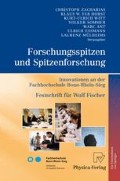Zusammenfassung
Von Fluiden durchströmte Rohr- und Kanalnetzwerke spielen in vielen technischen Anwendungen eine zentrale Rolle. Die beschreibenden hyperbolischen Modellgleichungen basieren auf Erhaltungsgesetzen von Masse, Impuls und Energie. Dazu können Konvektions-Diffusions-Reaktionsgleichungen kommen, falls die Fluide Inhaltsstoffe transportieren und deren chemisch-biologische Reaktionen betrachtet werden. Für die verschiedenen Modellgleichungen wird ein einheitlicher numerischer Lösungsansatz vorgeschlagen. Die Ortsdiskretisierung erfolgt mit dem Kurganov-Levi Verfahren. Damit können Stoßwellen aufgelöst werden, ohne auf die Eigenstruktur der hyperbolischen Systeme zurück zu greifen. Je nach Anwendungsgebiet können dann unterschiedliche Verfahren zur Lösung der entstehenden Systeme gewöhnlicher oder differential-algebraischer Gleichungssysteme eingesetzt werden. Anhand von Testproblemen mit unstetigem Lösungsverlauf wird die Eignung der gewählten Diskretisierungsansätze demonstriert.
Access this chapter
Tax calculation will be finalised at checkout
Purchases are for personal use only
Preview
Unable to display preview. Download preview PDF.
Literatur
Abdulle, A.: Fourth order Chebyshev methods with recurrence relation, SIAM Journal on Scientific Computing, 23, S 2041-2054, (2002).
Bourdarias, C., Gerbi, S.: A finite volume scheme for a model coupling free surface and pressurised flows in pipes, Journal of Computational and Applied Mathematics 209(1), 109-131 (2007).
Chapman et al.: Virtual Pipeline System Testbed to Optimize the U.S. Natural GasTransmission Pipeline System, The National Gas Machinery Laboratory Kansas State University (2005).
Geiser, J., Gedicke, J.: Iterative Operator-Splitting Methods with higher order Time-Integration Methods and Applications for Parabolic Partial Differential Equations, Preprints aus dem Institut für Mathematik 10, Humboldt-Universität zu Berlin (2006).
Hahne, E.: Technische Thermodynamik-Einführung und Anwendung-, Oldenbourg (2000).
Hairer, E., Wanner, G.: Solving Ordinary Differential Equations II, Stiff and differential algebraic Problems, (2nd ed.), Springer-Verlag, Berlin, (1996).
Hirsch, C.: Numerical Computation if Internal and External Flows. Volume 2, John Wiley & Sons (1984).
Hundsdorfer, W.; Verwer, J.G.: Numerical Solution of Time-Dependent Advection-Diffusion-Reaction Equations. Springer Verlag (2003).
Kurganov, A., Levy, D.:A third-order semidiscrete central scheme for conservation laws and convection-diffusion equations. SIAM J. Sci. Comput. Vol.22m No4, 1461-1488 (2000).
LeVeque, R.: Finite Volume Methods for Hyperbolic Problems, Cambridge University Press (2002).
Paschedag, A.R.: CFD in der Verfahrenstechnik, Wiley-VCH (2004).
Pirsing, A., Rosen, R., Obst, B., Montrone, F.: Einsatz mathematischer Optimierungsverfahren bei der Abflusssteuerung in Kanalnetzen, GWF-Wasser/Abwasser 147(5), S 376-383, (2006).
Podhaisky, H., Weiner, R., Schmitt, B.A.: Rosenbrock-type ’Peer’ two-step methods, Applied Numerical Mathematics 53,S 409-420, (2005).
Rentrop, P., Steinebach, G.: Model and numerical techniques for the alarm system of river Rhine, Surveys Math. Industry 6, S 245-265, (1997).
Seidl, S.: Runge-Kutta-Chebyshev Verfahren zur numerischen Simulation von Flachwassergleichungen in Kanalsystemen. Diplomarbeit, TU München, Fakultät für Mathematik (2007).
Shampine, L.F., Gladwell, I., Thompson, S.: Solving ODEs with MATLAB, Cambridge University Press (2003).
Shampine, L.F., Reichelt, M.W.: The Matlab ODE suite, SIAM J. Sci. Comput., 18(1), S 1–22, (1997).
Steinebach, G., Paffrath, M., Rentrop, R., Rosen, R., Seidl, S.: Process simulation for sewer systems – a case study –. Berichte aus den numerischen Arbeitsgruppen, NUM 2007, TU München (2007).
Steinebach, G., Rademacher, S., Rentrop, P., Schulz, M.: Mechanisms of coupling in river flow simulation systems. Journal of Computational and Applied Mathematics 168(1-2), S. 459-470 (2004).
Steinebach, G., Rentrop, P.: An adaptive method of lines approach for modelling flow and transport in rivers, in: A.Vande Wouver, Ph. Sauces, W.E. Schiesser (eds.), Adaptive method of lines, Chapman & Hall/CRC, S 181-205; (2001).
Steinebach, G., Rentrop, P.: Fließgewässersimulation zur Wasserstands- und Stofftransportvorhersage, Berichte aus den numerischen Arbeitsgruppen, NUM 2004, TU München (2004).
Stoker, J.J.: Water waves, the mathematical theory with applications. Interscience Publishers Inc., New York (1957).
Vreugdenhil, C.: Computational Hydraulics An Introduction, Springer-Verlag, NY (1989).
Author information
Authors and Affiliations
Editor information
Editors and Affiliations
Rights and permissions
Copyright information
© 2009 Physica-Verlag Heidelberg
About this chapter
Cite this chapter
Steinebach, G. (2009). Mathematische Modellbildung und numerische Methoden zur Strömungs-, Transport- und Reaktionssimulation in Netzwerken. In: Zacharias, C., et al. Forschungsspitzen und Spitzenforschung. Physica-Verlag HD. https://doi.org/10.1007/978-3-7908-2127-7_15
Download citation
DOI: https://doi.org/10.1007/978-3-7908-2127-7_15
Publisher Name: Physica-Verlag HD
Print ISBN: 978-3-7908-2126-0
Online ISBN: 978-3-7908-2127-7
eBook Packages: Humanities, Social Science (German Language)

